CARDAS AUDIO CLEAR
I assume there is no audio enthusiast out there who have never heard of Cardas Audio. Then the terms of ‘golden ratio’ or ´golden section´have probably got stuck in your head because there is no Cardas without the golden section. The Clear interconnect is the Cardas Audio's top of the range signal cable. And it proved itself to be one of the best pieces of wire I've had in my audio system.
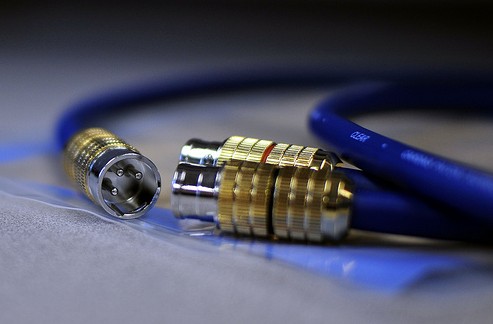
The substance of reality
Cardas Audio has earned great reputation over the years among both enthusiastic listeners and enthusiastic professionals. The internal Cardas wiring can be found in many renowned audio brands, including Jeff Rowland, Joseph Audio, Eggleston Works, Theta or Ayre. Without getting into boring details and numbers I will try and explain the rational of the Cardas Clear design and the sonic elements that make it so outstanding.
Sequencing the audio cable
Have you ever heard of numeric sequences that were introduced to mathematics around year 1200 by Leonardo Fibonacci? Now it is the right time to get acquainted with it. Let’s start with the first two numbers in the row: 1 and 2. Let’s add them – now we have another number, 3, to form the sequence of three numbers: 1, 2, 3.
Now let’s add again the last two numbers, 2+3=5, which is the next number in the row. And so on and on, you can continue endlessly, the only discipline required from you is the ability to sum two numbers. After few iterations the row might look like this:
1, 2, 3, 5, 8, 13, 21, 34, 55, 89, 144, 233, 377, 610, 987, 1597, 2584, 4181, 6765, 10946, etc.
Now we have data enough to arrive to two important conclusions. First, if you draw squares with the widths that you have just calculated, you get a nice evolving spiral, like on the following picture:
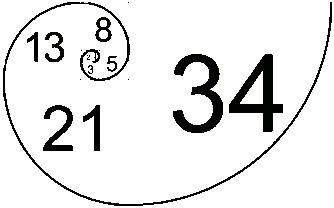
Second, when you take any two successive numbers, their ratio always gives the number 1.61803… which is the GOLDEN RATIO or GOLDEN SECTION number. The bigger two successive numbers you divide, the more precise the result will be, yet the basic picture looks already quite identical for relatively small numbers, like 233:144=1.61805
George Cardas was the first who introduced the concept of the Golden Section based Constant "Q" Stranding to high-end audio and got it patented. However, the Golden Ratio seems to be the mathematical proportion of nature, of life itself, it is often the heart of musical scales and chords and it is incorporated in many works of art and architecture. There is a lot of artificial mysticism around this number (e.g. it is claimed to be used by the Egyptians in the Great Pyramid centuries before, or by builders of temples in the Ancient Greece) so it may have flavor of occultism rather than scientific base for many technically-thinking people. There is no room for divinity in the world of high-end audio, although many manufacturers rely upon it.
Demystifying the audio cable
Indeed, if one strongly believes in divine proportions, he or she may see them everywhere. To keep your (and mine) feet on the ground I would like to quote a passage from Umberto Eco’s excellent Foucalt’s Pendulum book, in which the ageless occultist Aglie demonstrates to his friend how sacred geometries can be applied to virtually anything – in his case a wooden kiosk in the street below:
“Gentlemen,” he said, “I invite you to go and measure that kiosk. You will see that the length of the counter is one hundred and forty-nine centimeters—in other words, one hundred-billionth of the distance between the earth and the sun. The height at the rear, one hundred and seventy-six centimeters, divided by the width of the window, fifty-six centimeters, is 3.14. The height at the front is nineteen decimeters, equal, in other words, to the number of years of the Greek lunar cycle. The sum of the heights of the two front corners and the two rear corners is one hundred and ninety times two plus one hundred and seventy-six times two, which equals seven hundred and thirty-two, the date of the victory at Poitiers. The thickness of the counter is 3.10 centimeters, and the width of the cornice of the window is 8.8 centimeters. Replacing the numbers before the decimals by the corresponding letters of the alphabet, we obtain C for ten and H for eight, or C10H8, which is the formula for naphthalene.”
As you can read, one has to be cautious to separate the marketing from the solid fundamentals. On the other hand, the proportionality of the golden section can be scientifically applicable to many areas of nature and life - let’s now be back to the science behind the golden section in the Cardas Clear.
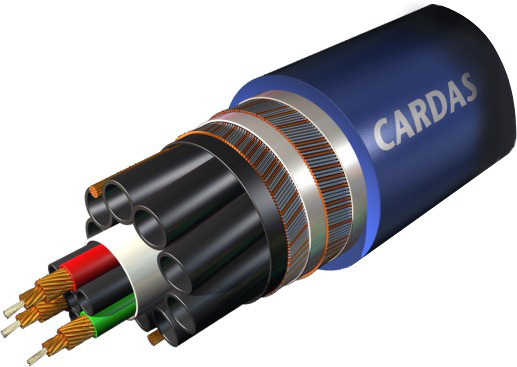
Rationalizing the audio cable
I have already discussed implementation of the golden ratio in Cardas’ cables on the opportunity of the group review of his other interconnects and speaker cables in the paragraph that was headlined Obsession or perfectionism? So let me make a short summary once again.
George Cardas claims that resonant behavior of a conductor or a strand is the reason for performance gaps in many cables. Each and every strand in a cable has its own ´sound´ due to vibrations and ringing on the microscale. Two or more wires of the same mass and tension have common mechanical resonating points and share the same note. Two or more wires or bundles of wires, differing in size, each have their own resonant points. When combined, wires find new points of interaction, creating yet another note.
There is a solution - create a multiple strand conductor, where the individual strands share no common mathematical node or resonant point and layer them to cancel the noise they each create. In the Clear´s golden section stranding, individual strands are arranged so each strand is coupled to another, whose note or sound is irrational with its own, thus nulling inter-strand resonance.
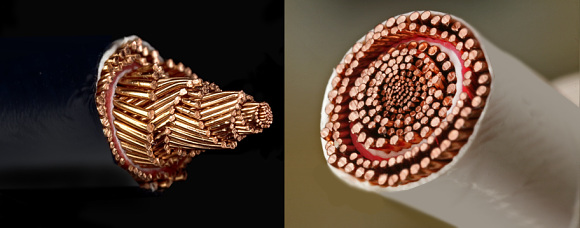
On top of that, Cardas claims that at the heart of cable oscillation is delayed or stored energy. This energy results from the lowered internal ´Q´(resonant point) of conventional conductors. Cardas cables employ a unique stranding method where strands diminish in size towards the interior of the conductor. This design is called Constant Q Stranding and it allows each strand of the cable to share the load equally. It is a very effective method of reducing the non-linearity seen in conventional conductors, without compromising the symmetry of the conductor or the capacitance of the cable.
Cable resonance is further reduced through the use of ultrapure copper and air dielectrics. Cardas uses diamond dies and cutters exclusively, drawing the strands in a hydrogen reduction atmosphere to reduce impurities and surface contaminations. Each and every strand is immediately coated with enamel coating so there is no chance for the copper to oxidize before it is airtight-sealed in the cable. Actually, Cardas Audio is one of the few manufacturers that draw their own conductors from copper rods instead of outsourcing the wires from elsewhere like the most do.
Apart from pure copper the inside of the Clear is full of Teflon that is used to insulate the wires as well as control dielectrics through hollow Teflon tubes in which the strands are embedded. The cable´s dual spiral shielding employs Teflon-graphite composition too. Overall, the engineering of the cable is very serious.
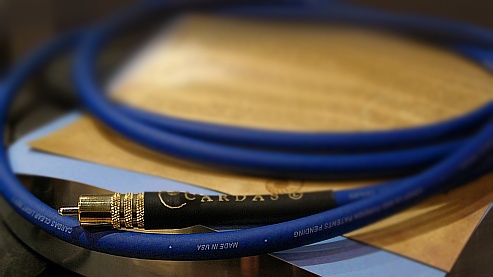
Auditioning the Clear – an executive summary
Should I attempt and sum all my findings in one paragraph? Those who hate a reviewer’s usual audio-poetry can use the following sentences as a kind of ‘executive summary’.
Foremost, the Cardas Clear provides realistic weight, scale and body. All these elements result into natural palpability of instruments and humans within a well-defined soundstage. The bass takes clarity and presence without any slowing or slurring yet it possesses the tinniest hint of warmth and roundness that lend organic rather than technical feeling to the music. The sweet clarity brings color, musical detail and separation to the midrange that is opened up and communicative with the Clear.
I love going to live classical performances and rehearsals, sometimes for enjoyment, sometimes for sound dissections. Apart from other less important elements I am always mesmerized by how finely the live unamplified sound is woven and how clearly it is defined. It is not the usual audiophile hyper-definition with surgical imaging – rather it is a silky canvas inhabited by myriads of microdynamic textures and free of any dust or fuzziness. Yet the dust, haze and veils, be it noise, interferences, discontinuities or temporal errors, are traceable in most high-end cables, some being twice or thrice the price of the Clear. The Clear was perhaps not removing anything from the recorded material (like some other cables do), but on top of that it was very efficient in not adding anything and most importantly not altering the essence of live sound. Thus the sonic picture of an orchestra was dramatically transparent, spacious, communicative and intelligible, dynamic and tonally correct, without lacking the fluidum and the aura that surrounds the performance, without becoming technocratic or self-indulgent.
Auditioning the Clear – the details
I’ve been sharing my listening room with two sets of the Cardas Clear for over four months now. They interconnect Accuphase C-2110 control center and Accuphase DP-78 SACD player with Accuphase A-60 power amplifier in fully balanced configuration. On top of that, they were validated also in Ayre-driven system (Ayre K-5xe and Ayre P-5xe) as well as with Bel Canto’s Pre3 and REF1000 monos. Matching a cable with a system can be a trudge as the cable compensates or accents flaws of the electronics and vice versa. With any Cardas I have ever auditioned in any system the matching was much easier and the job was even easier the higher I moved in Cardas’ catalogue. The Clear is so transparent and leaves so little its own imprint on the sound that it can be used almost universally. I would even dare to put it differently: if the Cardas Clear spoils the sound of your system, keep the Clear and replace the system as there is obviously something wrong elsewhere along the signal path.
After the months with the Clear it is not easy to illustrate its sonic abilities without discriminating some recordings - I simply listened to too many albums that had sounded great - greater than without the Clear . Therefore I will only focus on one outstanding disc to describe the Clear’s benefits.
I believe that Chesky Records’ The Ultimate Demonstration Disc Vol.2 should be the part of any serious audiophile library. Now it is available on SACD (Chesky, SACD 343) with spectacular sound and enhanced liner notes to tease your system’s abilities as far as resolution, purity, dynamic, transparency or imaging are concerned. And much more than that. In search of the as-close-to-reality-as-possible sound the Chesky’s team did not use any overdubs, compressors, limiters or multitracking – “the sessions were taken on live microphones the way the mics hear what you would have heard if you were at the sessions.”
In the track #1, In A Mellow Tone (from Sugar Hill: The Music of Duke Ellington and Billy Strayhorn) the brushed cymbals’ sizzle is recorded quite hot, yet it is finely resolved and beautifully metallic without ever turning into white hiss. Quite opposite, especially through the Bowers & Wilkins 802 Diamond’s spectacular tweeter I had to appreciate the increased sense of body and color that the Clear injected into the highs. Where my previous Nordost Valhalla and HGA DNA references were precise, clean and focused, the Clear added innocent purity and was more lifelike. The Paul Gill’s bass was a tad thinner with the competitors as well as buried deeper in the mix – the Clear added the flesh on bones to render the size and the substance of the instrument. It let harmonies fully develop and the fat strings exciting the body of the bass could resonate with colorful definition.
The initial drumstick rim lick in Speak Like A Child of John Faddis is typical Cardas. I have no clue why different materials are reported so naturally and obviously with Cardas - wood is wood and metal is metal, one can almost feel the resilient deformation of the wooden stick against the drum’s rim. The Clear brought my attention to a screeching sound at the beginning of the track and once again around 2´05 mark – I could not identify its origin, it sounded like someone tightened rusty nut or tried to mobilize a twenty years old trumpet. Whatever the sound was it was perfectly locked within the three-dimensional soundstage and became the organic part of music. And the music? Have you ever been at a jazz club? This is the Clear – natural, omnipresent, forget about rendering a live event – this is the live event. The difference between the listening to music and the listening to music through the Clear is like the difference between a standard movie and its 3D version – the Cardas enhances the experience in all dimensions to come up with an illusion that is very palpable.
Club Descarga (The Body Acoustic) places nicely recorded conga drums just behind the plane of speakers. If you like to listen with open eyes to see how palms are hitting the tightened skins then look no more. The sound was very precise and dynamic through the Nordost Valhalla, yet a bit thin, and a bit boomy through other competitors. The Clear was proportionally correct – it married rhythmical articulation and sure-footed presentation with temporal and spatial integrity and added flesh onto bones. The sonorous timbre of basclarinet that joins the track later on was free of any nasal coloration and the air flowing through the mouthpiece and the bell was flavored with wood without being anemic or sterile. The transparency and seamless space of this recording are clearly apparent, the soloists perfectly positioned, their instruments presented with palpable and real immediacy and presence, it is a very physical listening experience.
David Chesky’s recordings are a great tool to check the interaction of your audio chain with the room acoustics – the solo voices are usually not centered but mastered slightly off center to either side of the microphone. Too reverberant spaces will not provide desired focus and correct placement of the voices, too absorbent rooms lose spark and soft ambient clues that are necessary to reconstruct the recording venue. The high-end audio is like a gem with many facets – to polish them all at the same time requires patience and a decent bank account.
Imagine of Rachel Z is a difficult track. The “acoustically-industrial”cover version of the John Lennon’s classic features deep bass, wild cymbal splashes and almost disharmonic upper piano registers that may have the tendency towards nastiness if the components cannot control them or they may be clumped and confused if there is lack of transparency. It is the recording where spectral honesty, separation yet organic unity and ability to resolve the tinniest details are required to enjoy it. At least from the sonic perspective. If you get it right like I did through the Clear, the track that I tended to skip before, becomes fascinating.

Traumatizing the Clear
Unlike the other Cardas cables I did not have the impression that the Clear would require an extreme breaking in period. True, I had cooked the Clear on Blue Horizon ProBurn device for almost 3 days prior to critical listening which may equal to over to 100 hrs of standard playback. Still, comparing the heated up Clear with another sample that was unpacked fresh out of its plastic bag did not show night and day differences, rather refinements and subtleties. The subtleties may be quite important, however.
The effect of proper settling-in is remarkably audible after the cable is manipulated. The effect of mechanical stress impairing the sound is apparent also with other cables to certain degree, however, with the Clear those imperfections are better to spot due its honest transparency. I can only speculate that the special way in which the individual wires of the cable are arranged to mutually interact is the reason for the Clear to alter its ´sound´ when it is disconnected and reconnected, bended or otherwise disturbed. It takes some time afterwards before the Clear settles back. Therefore be cautious when comparing the Cardas Clear in your dealer´s showroom as most likely you will not be able to hear its full potential.
Any drawbacks?
I personally like the softened polyurethane jacket of the Clear. The cable’s protection is durable, flexible and leaves no scratches on components or furniture like some other stiffer cables do (my SACD player would tell you story about the visit of Gigawatt LC-3 power lead that left some scars on it) and the jacket also works as elastic decoupling of the cable from its surroundings to reduce transfer of resonances. The only issue is that it is navy blue which makes it difficult blend with interior. And it looks way too ordinary. Put the Clear next to Furutech’s Lineflux and you’d guess the Clear to be rather something that your electrician left at your house. Simple plastic bag with a printed paper card inside does not attest the high-end status of the cable either. This is not a complaint, quite opposite, as packaging is a disposable thing and we should spend our money on sound, don’t we? With the Clear there is no mark-up for gloves and a wooden box.
The Clear uses terminations that have been developed specially for it. Cardas provides CGXLR connectors for balanced and SRCA for single-ended versions, both providing rhodium plated contact areas. With Cardas you can be sure that the metallurgy of the connectors is first rate and far away from cheap gold-on-brass plating of stock cables. Cardas Audio is famous for its eutectic solder, the Clear’s connectors are crimped (or cold welded) however for ultimate unity of the wire and the connector’s body. The method, that is used by Audioquest or Silver Audio, prevents oxidation or contaminations, especially if even the stripping before crimping happens in controlled inert atmosphere in Cardas Audio.
Perhaps the 'drawback' title of this paragraph was a bit inappropriate. It is next to impossible to find faults with the Clear – I believe that within its price range (MRSP: €2140/1m pair) there is no serious contender. I have auditioned dozens of reputable interconnects as well as many astronomically priced and esoteric designs; to be honest so far I have found only one – Audioquest’s Wild Blue Yonder at twice the Clear’s price – that was superior to the Clear and vastly superior to anything else.
SK: Platan Audio, Hlohovec / Bratislava, tel. +421 905 409 802
CZ: Excelia HiFi, Chrudim, tel. +420 724 00 77 44



